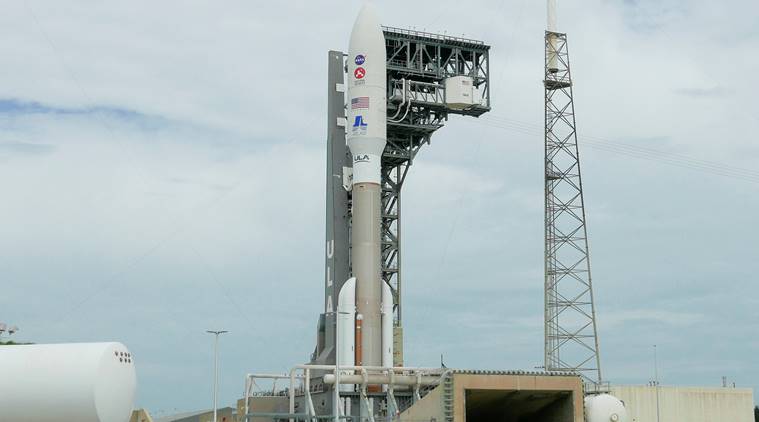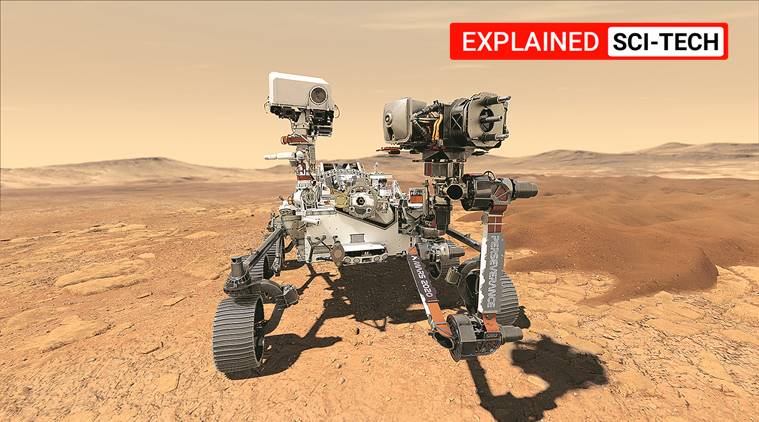 A United Launch Alliance Atlas V rocket carrying NASA’s Mars 2020 Perseverance Rover vehicle is readied for launch at the Cape Canaveral Air Force Station in Cape Canaveral, Florida (Source: Reuters)
A United Launch Alliance Atlas V rocket carrying NASA’s Mars 2020 Perseverance Rover vehicle is readied for launch at the Cape Canaveral Air Force Station in Cape Canaveral, Florida (Source: Reuters)
NASA’s Mars 2020 Perseverance rover launch highlights: NASA launched its Mars Perseverance Rover on July 30 at 17:20 IST from Cape Canaveral Air Force Station, Florida. The main aim of the Mars Perseverance Rover is to seek signs of ancient life and collect rock and soil samples for a possible return to Earth. The duration of the mission is expected to be at least one Mars year which is equivalent to 687 days on Earth.
The Mars Perseverance Rover is expected to land on Mars on February 18, 2021, after covering a distance of 300 million miles (482.8 million kms approximately). The landing site of the rover will be the Jezero Crater on the Red Planet. This is the third launch to Mars after China’s rover-orbiter combo and a United Arab Emirates orbiter launched last week.
LIVE NOW: The #CountdownToMars begins.
We are launching a historic mission to the Red Planet. Tune in to watch @NASAPersevere liftoff and begin her mission to search for signs of ancient life on another world: https://t.co/JxyRCol01i
— NASA (@NASA) July 30, 2020
https://platform.twitter.com/widgets.js
“We don’t know if life existed there or not. But we do know that Mars at one point in its history was habitable,” NASA Administrator Jim Bridenstine said on the eve of the launch.
"Our launch process is complete. The vehicle is on its way to Mars." NASA Perseverance Rover chief engineer Adam Stelzner discusses the next seven months leading up to landing on the Red Planet. WATCH
NASA launched its latest Mars rover, dubbed Perseverance, on Thursday, the first step in the space agency’s newest effort to hunt for signs of ancient microbial life and collect samples that will eventually be returned to Earth. The rover blasted off from Cape Canaveral in Florida atop an Atlas V rocket, beginning its 6 ½ month trip to the red planet. Destined to land in Jezero Crater on Feb. 18, this is the latest effort by the U.S. space agency to learn more about the Martian atmosphere and surface. Perseverance is also carrying a small helicopter named Ingenuity, which if successful will be “the first aircraft to fly in a controlled way on another planet,” NASA said.
READ details here
The Mars Perseverance Rover is expected to land on Mars on February 18, 2021, more than six months from the launch.
Mars Perseverance has officially been lifted off and is travelling at great speeds before the launch.
The launch will go ahead despite an earthquake in Los Angeles.
There is a two-hour launch window. Perseverance will blast off aboard a United Launch Alliance (ULA) Atlas V 541 rocket to embark on its seven-month journey to the Red Planet. NASA’s Launch Services Program, (LSP) based at Kennedy, is managing the launch.
While the rover explores Jezero Crater, collecting rock and soil samples for future return to Earth, five small pieces of spacesuit material will be studied by an instrument aboard Perseverance called SHERLOC (Scanning Habitable Environments with Raman & Luminescence for Organics & Chemicals). The materials, including a piece of helmet visor, are embedded alongside a fragment of a Martian meteorite in SHERLOC's calibration target. That's what scientists use to make sure an instrument's settings are correct, comparing readings on Mars to base-level readings they got on Earth.
Imagine driving on the loneliest road in the world. For the traveller, it is a cathartic experience. One can drive for hours on end without seeing another car or human being. There is the wilderness, the landscape of mountains and valleys, the open sky above and the spectacular night bejewelled by stars. Driving on Mars is a somewhat similar experience. Except there is no road. The rover can drive anywhere it chooses to, and is able to. Except no human or machine has driven on the road before. That is the rush of operating a rover on Mars.
READ MORE
